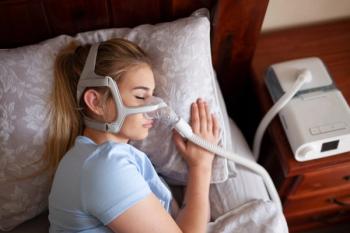
GLP-1s Likely New Frontier in the Treatment of OSA, Obesity in Sleep Medicine
Key Takeaways
- GLP-1 inhibitors, like tirzepatide, show promise in reducing AHI in OSA patients with obesity, as demonstrated in the SURMOUNT trials.
- Experts highlight the importance of integrating GLP-1s with diet and exercise for effective OSA management, without replacing CPAP therapy.
The efficacy of GLP-1 inhibitors in weight loss has introduced them as a means of also addressing obstructive sleep apnea in sleep medicine.
Glucagon-like peptide-1 (GLP-1) inhibitors have been the talk of medicine for several years, with promising results in weight loss and cardiology, among other uses. This is no different in sleep medicine, as a panel of experts in sleep medicine and nutrition weighed in on the use of GLP-1s to address obstructive
GLP-1s Have Shown Promise in OSA in Clinical Trial
With the success GLP-1s have had in
The SURMOUNT trials, with results coauthored by Malhotra himself,2 evaluated the efficacy of tirzepatide in adults with moderate to severe OSA and obesity, with the first trial including adults who were not using continuous positive airway pressure (CPAP) and the second trial including those who were receiving CPAP. Patients received either 10 mg or 15 mg of tirzepatide or placebo in the randomized trial.
“There’s no direct comparison of tirzepatide to CPAP because attempting to draw conclusions about that, we can’t,” explained Malhotra.
The first trial had a mean apnea-hypopnea index (AHI) at baseline of 51.5 events per hour, and the second trial had a mean AHI of 49.5 events. The mean body mass indices were 39.1 and 38.7 for the first and second trials. There were mean changes in AHI of –25.3 in the first trial and –29.3 events in the second trial when using tirzepatide. In comparison, AHI only decreased by –5.3 and –5.5 events per hour in the placebo groups in the first and second trials, respectively.
“Tirzepatide demonstrates superior improvement in patient-reported outcomes in quality of sleep and sleep clinic functioning…[and] clinically meaningful improvements in OSA and obesity and cardiovascular risk factors,” said Malhotra. “The safety profile of tirzepatide in moderate to severe sleep apnea and obesity is generally consistent with the safety profile of tirzepatide increment-based therapies for people with obesity.”
Experts Weigh in on Use of GLP-1s in Practice
A panel of experts followed Malhotra’s presentation to speak about their own use of GLP-1s in their sleep medicine practices, with a weight management expert also in attendance to address her side of medicine. The prescribing of GLP-1s across practices was of note, as the panelists had mixed experience in actually prescribing the medication for sleep.
“I just started doing that at our institution. It’s been a little bit heterogeneous and from a sleep standpoint, obviously obesity medicine and primary care prescribing… our obesity management wait times [are] 8 to 9 months to get in, so they can’t manage this by themselves,” said Dennis Auckley, MD, a pulmonologist at MetroHealth Medical Center. “We’re working right now on trying to standardize it across our system, particularly within sleep medicine.”
“One in 4 Americans is taking GLP-1 receptor agonists at this point, so if you’re not prescribing it, it’s a matter of time before you are because many patients are getting these medications,” said Malhotra.
Nancy Callop, MD, director of the Emory Sleep Center and former president of the American Academy of Sleep Medicine, explained that, although she has not prescribed it herself, educational sessions with providers were held and younger internal medicine providers were more comfortable with it due to experience during their residency. Ultimately, individual providers were left to make the judgement on prescribing GLP-1s.
Babak Mokhlesi, MD, chief of pulmonary, critical care, and sleep medicine at Rush University, joked that his wife got him some free samples of semaglutide and tirzepatide. “I just wanted to try it myself, see how it feels, and do it well as a patient. Well, I’m not on it, just a couple of shots,” Mokhlesi joked with a smile amid laughter from the panelists and audience.
He went on to explain that he has begun prescribing it. “As somebody in a leadership position, I’m trying to work with our finance team to make a business argument to expand our clinical services and recruit people to help us do this… I’ve had a few cases of success with the insurance companies, so it’s a work in progress,” he said.
The Ohio State University has a weight management program, explained Aneesa Das, MD, professor of internal medicine at The Ohio State University Medical Center, where fellow panelist Allison Rhodes, MD, assistant professor of clinical medicine, works. However, they both noted that wait times are very long, which can delay care when the patient primarily needs the medication to address their OSA.
The panelists also emphasized that diet and exercise are essential to using GLP-1s in this way, with Malhotra noting that tirzepatide improves some areas of diet. “Something called hedonic eating, which is eating for pleasure rather than eating for hunger, [and] we call food noise; that goes away on this medication because a lot of patients report that,” he explained.
Rhodes described the 4 pillars of health: nutrition, physical activity, sleep and stress management, and medical management. When it comes to continuing the use of tirzepatide, patients have to prove that they are putting in the work in the essential pillars. “Patients have to give me a 24-hour diet recall in order to get a refill request. They tell me how much water they’re drinking, they have to tell me their steps per day, they’ve got to tell me what they’re doing for resistance training…they’ve got to tell me how many hours of sleep they’re getting per day, what they’re doing in that hour before bed,” she explained.
The panelists also reiterated that the use of GLP-1s does not always take the place of the use of CPAP if someone is looking to get off the use of those machines. Although some patients may be able to stop using CPAP after losing weight, this is not always the case.
“Every patient’s so different, and some patients are quite obese with quite severe apnea, and some patients are obese and they don’t have severe apnea, so you’re going to treat them very differently,” said Callop. “From our bariatric population, we know that a lot of those people who still lose weight still have sleep apnea, but what it does do a lot of times is move them into a different category, so they may be available to…some other therapy.”
Rhodes encouraged her patients to slow their weight loss and keep their CPAP to preserve as much function as possible and lose weight in a more sustainable way, shooting for 20% of their body weight loss over a period of closer to a year rather than 6 months.
To conclude the panel, Das reiterated that, even if a sleep doctor has not yet prescribed a GLP-1, it is likely that it will come in the future, which makes it vital that sleep doctors become familiar with it in order to help their patients with OSA in the future.
“It’s going to come down to sleep providers are going to do it. We have at least 1 payer in the state of Ohio that requires that you’re board-certified in sleep medicine in order to prescribe it for the indication of OSA…so that’s going to happen,” she concluded.
References
1. Sleep apnea. Cleveland Clinic. Updated January 15, 2025. Accessed October 20, 2025.
2. Malhotra A, Grunstein RR, Fietze I, et al. Tirzepatide for the treatment of obstructive sleep apnea and obesity. N Engl J Med. 2024;391(15):1193-1205. doi:10.1056/NEJMoa2404881
Newsletter
Stay ahead of policy, cost, and value—subscribe to AJMC for expert insights at the intersection of clinical care and health economics.







































